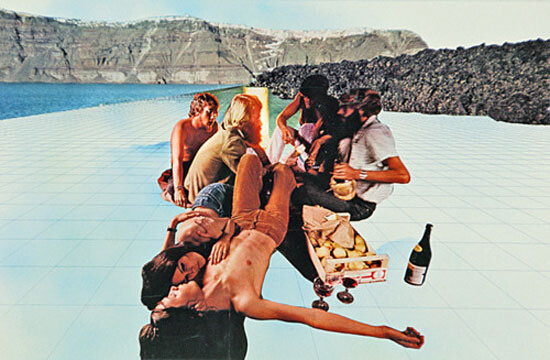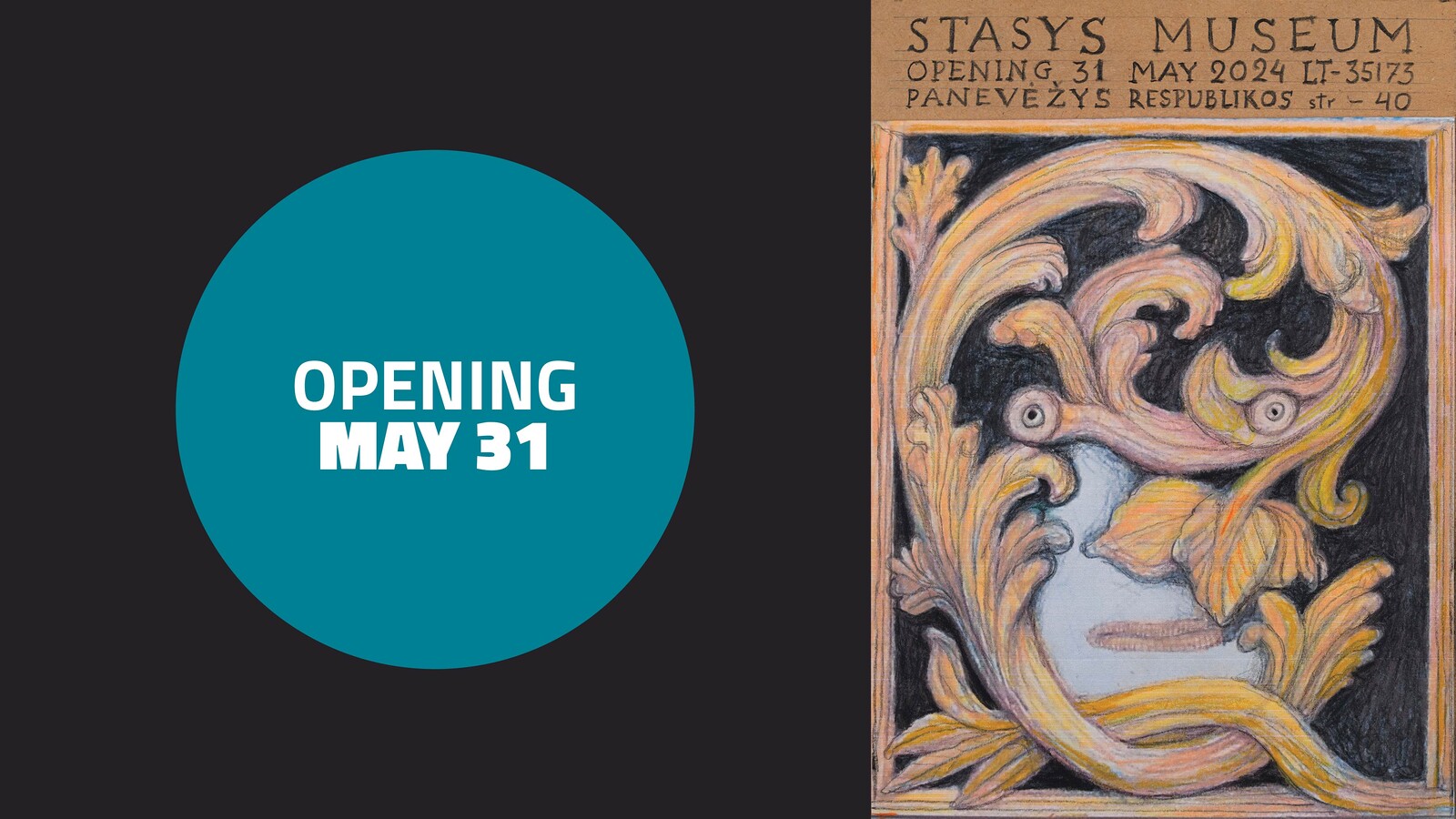In 1972, as part of MoMA’s exhibition “Italy: The New Domestic Landscape,” the Radical Design group Superstudio installed a small cubic room with mirrored walls that appeared to replicate itself into infinity. The group’s proposal, submitted to the curator Emilio Ambasz, had taken the form of a one-page statement describing exactly how this “microenvironment” should be installed, followed by a further nine typed pages of theoretical exposition by Superstudio’s cofounder Adolfo Natalini. In those nine pages—a manifesto of sorts, veering off into prose poems and short stories—Natalini outlines a new way of living. The attributes of this hypothetical existence include “permanent nomadism,” “life without objects,” and “life without work.” These conditions are made possible by a mysterious gridded structure that Natalini refers to only as “the network.”
It is only too easy to root around in the archives, extract something highly selective, and proclaim this or that radical to have been prophetic. In this case, however, Natalini’s vision appears uncannily prescient. Of course, “the network” of his imagination was simply an act of wish fulfillment—he hadn’t the slightest idea what it was exactly (although, by coincidence, 1972 was also the year that ARPANET was first demonstrated in public), he knew only that it was a “total system of communication.” In Superstudio’s photo-collages, it took the form of a grid—either an abstract gridded plane or a gridded megastructure called The Continuous Monument. Theirs was only a mock utopia, serving to critique both modernism and consumerism, and yet, ineluctably, the network came to pass. It is not, however, a megastructure. In fact, for all intents and purposes—for the majority who cannot see the server farms and the undersea cables—it is invisible.
The effects of the network age on urban life in the early twenty-first century are roughly as Natalini predicted, if less utopian. Immaterial labor has led to a flexible but precarious existence in which, for the young at least, “permanent nomadism” is not so far from the truth. Objects, meanwhile, are dematerializing into live streams, downloads, e-books, smartphone apps, and the so-called “sharing economy.” We have witnessed the primacy of software over hardware.
Most significantly, what we think of as “domestic space” is being completely redefined. We need look no further than the rise and rise of Airbnb. The rental website epitomizes a new era of nomadic, vicarious living, in which one can simply slip into different lifestyles like dresses. Its evangelists proclaim a utopian mission of sharing over owning (CEO Brian Chesky famously claims not to own a home), and like good neo-Marxists they talk of use-value rather than exchange-value. But of course Airbnb enables a global population to be part of the rentier class. It is as much a symptom of precarity as of networked living—it is the means by which many now pay their own rents and mortgages. Airbnb is what we have instead of state-subsidized affordable housing, and it is leading to the wholesale commodification of domestic space.
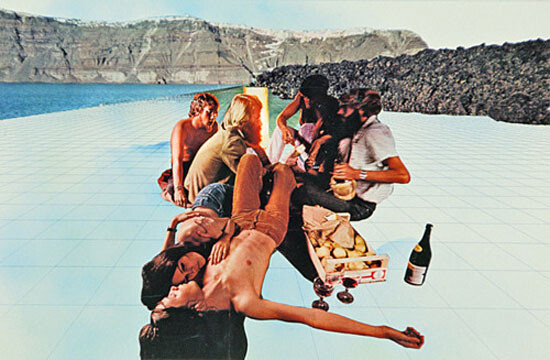

For the first time since the mid-twentieth century—with its labor-saving household appliances and rising quality of life—the domestic is once again the site of radical change. And though domestic space appears to fall within the realm of architecture, architects themselves have been almost mute on the implications of such change. Architecture, it seems, has given up its dreams of imagining how we might live, and so into that void technology is rushing. That tired old trope of “the house of the future” has been replaced by what is now called the “smart home.” The smart home is the network’s great white hope for ubiquitous connectivity. It sounds benign enough, and may conjure Jacques Tati-style mise-en-scènes populated by absurd devices—the smart home is prime territory for farce—but it is also an ideology. It is the house-shaped manifestation of the internet of things, according to which all our devices and appliances will join the network, communicating with us and each other.
To say that the internet of things is an ideology is to suggest that the use-value of the concept has yet to be sold to the consumer. It is easily mocked by skeptical hacks who question the need for talking fridges and washing machines that you can program with your smartphone (“You still need to put the clothes in yourself, right?”). Bruce Sterling argues that the internet of things has nothing to do with the consumer and everything to do with the business interests of the service providers. Given that data is the new currency, the internet of things is an epic power grab by the lords of the network—Sterling focuses on the “big five” of Google, Amazon, Facebook, Apple, and Microsoft—to gain control of as much human data as physically possible.1 As the primary interface of the internet of things, the smart home is effectively the tendrils of the network rising out of the ground and into every one of our household appliances to allow mass data collection and digital surveillance.
That, at least, is one interpretation. It goes without saying that the internet of things agenda is being driven by the technology industry with the eager boosterism of the business community, which sees a blizzard of dollar signs. And while the evangelists of the IoT would hardly define themselves in Sterling’s terms, neither do they contradict him. As an effusive cover story in the Harvard Business Review put it recently, “It is the expanded capabilities of smart, connected products and the data they generate that are ushering in a new era of competition.”2 For better or worse, the smart home is the new New Domestic Landscape.
The question is, what are the implications for architecture? Do these developments have spatial ramifications? Should we plan and build in new ways to accommodate this technological surge, or is it just a case of running a few extra wires into the walls? Can architects continue to design according to age-old principles of good form and sound proportions (or stick to the boilerplate floor plans prescribed by greedy developers, as the case may be)?
The history of architectural historians overlooking the impact of technological innovations is a long one, and its best chronicler was Reyner Banham. In The Architecture of the Well-Tempered Environment, he charts the effects of successive environmental revolutions, such as electric lighting and air-conditioning, on built form. Banham’s geeky enthusiasm for ducting and electrical services enables him to propose a parallel history of architecture according to which the Royal Victoria Hospital in Belfast (1903), despite its outmoded, castellated styling, was “far more pioneering than anything that had been designed by Walter Gropius” because it was the first building to include a form of air-conditioning.
The trajectory of this parallel history takes in the invention of the suspended ceiling, in the late 1940s, which was required to hide the electrical services once concrete floor slabs had done away with the “dead spaces” in which that messy tangle used to be hidden. Banham can gleefully point out that the advent of the suspended ceiling, now ubiquitous in commercial buildings the world over, passed without comment in architectural literature. And yet it is precisely such technical details that allow for the “Cartesian glass prism” of Le Corbusier’s United Nations building in Manhattan—and thereafter the International Style—to exist in the first place.
So are we in danger of overlooking a similar technical detail when it comes to the internet of things and the smart home? After all, before revolutionizing architecture, air-conditioning was slow to catch on (introduced first in factories and then in cinemas, where it was most cost effective). But there is one salient difference. When air-conditioning finally took off as a domestic revolution, after the Second World War, millions and millions of consumers knew exactly why they wanted it. One cannot yet say the same of the smart home.
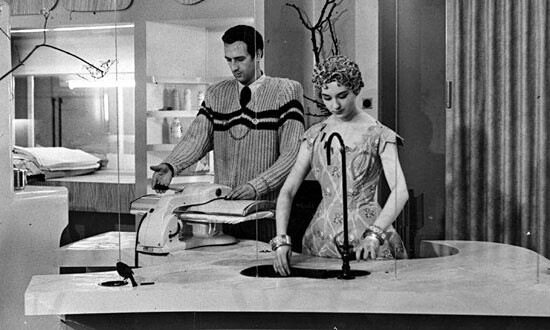

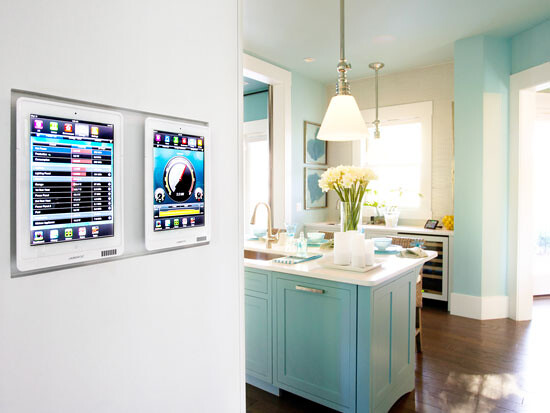

Just What Is It That Makes Today’s Homes So Different, So Unnerving?
The internet-of-things evangelists proclaim that it is that most “disruptive” of phenomena: a paradigm shift. Bearing in mind Banham’s assertion that electrification was “the greatest environmental revolution in human history since the domestication of fire,” one naturally looks for equivalent consequences when it is claimed (no doubt accurately) that “the network is the new electricity.”3 So just how, exactly, will the internet of things revolutionize domestic life?
The proposals to sell this revolution to the consumer are myriad and many splendored. But perhaps the poster product of this new domestic landscape is the Nest smart thermostat, which not only tells you exactly how much energy you’re using but can also learn your energy-use patterns and adjust itself according to your established preferences. The ostensible motive is environmental sustainability—Nest is helping us be better planetary citizens. But of course the reason why Nest was purchased by Google is that its smart thermostat is also a data hoover—a point we shall return to later.
The potential applications of the domestic internet of things cover a whole array of multi-billion-dollar industries, from security and healthcare to lifestyle and gaming. Thus Microsoft is developing kitchen counters that can recognize foodstuffs and display appropriate recipes. There are smart mattresses that monitor your sleep patterns by measuring your breathing and your heart rate. There are any number of smart locks now available that open when you walk up to the door and that can be programmed to let in your friends or guests (perfect for the Airbnb generation). There is cautious excitement about the potential of “ambient assisted living” for the elderly. A University of Manchester research group has developed smart carpeting that can tell when someone has fallen and that can even diagnose potential mobility problems from their footsteps.
Most of these products correspond to Arthur C. Clarke’s third law: “Any sufficiently advanced technology is indistinguishable from magic.” And it may well be that magic is precisely the quality that will seduce the consumer into embracing a world of all smart mod cons. The world of hyper-performance products, colluding in a domestic ecosystem that we barely understand but that lay its manifest intelligence at our disposal, may be our inevitable destiny. Banham was skeptical about this, averring with amusing bathos that while space capsules may require omni-competence, “here on Earth it will often prove that drawing a blind over a window … is all that is required.”4 More trenchantly, Sterling argues that we the consumer will have little choice in the matter either way. The internet of things is like electrification: if we are even able to opt out, we will simply be routed around and made redundant.
In the meantime, there are various intractable problems to solve. Some of them are technical. For instance, it is widely understood that the effective interconnectivity of all our household devices—their ability to sync and update and communicate with each other—depends on a single unifying platform. All tech companies agree on this and that is why they are all beavering away at solving the problem with their own proprietary platform that will not work with all the others. The idea that all our products may have to be either Apple-compatible or, say, Samsung-compatible, is a disincentive. As for the rapid cycle of updates and obsolescence, well, architects simply do not think in such ephemeral time spans. There are also security concerns: our houses become eminently more hackable the more connected devices we have. Experts evoke a cyber-security nightmare of “botnet” armies using smart toasters to launch DDoS attacks, etc. But let’s concern ourselves with the ethical implications of the smart home. Because if we are in the midst of a subtle domestic revolution, its consequences are in new forms of labor, the erosion of privacy, and the monopolization of control.
It is a truism worth restating here that our homes are increasingly the primary sites of production. This is not just true of new flexible labor models that allow many people to work from home; it also applies to the so-called “sharing economy” (read the digital rental economy) that allows us to commodify our private spaces so effortlessly. Already, the idea of the home as a retreat, a sanctuary from work, comes into question. But it is also literally true that our homes are sites of production simply by dint of rising property values. In London, with its 18 percent price rises in recent years, it is quite likely that your home makes more money every year than you do.
Added to this is the fact that the proliferation of smart, connected products will turn the home into a prime data collection node. It is estimated that there will be fifty billion wi-fi-connected devices by 2020, and all of them will collect data that is transmitted to and stored by their manufacturers. In short, the home is becoming a data factory.
Our participation in this process has been underway for some time, not least through social media, which has helped constitute the post-Fordist world in which we no longer fabricate machine parts but subjectivities—opinions, lifestyle choices, our public image. Different theorists come at this from different angles. Zygmunt Bauman calls it the commodification of the self, while Franco “Bifo” Berardi calls it “cognitive labor,” which is essentially a labor of communication. It is not hard to extrapolate Berardi’s theory of the info-commodity to the smart home. The insidious aspect of the smart home is that even as we go about our lives consciously producing data—as happily tweeting members of the “cognitariat”—we will also produce vast quantities unconsciously. Some of this data will be of use to us—knowing how much energy we are using or knowing on the way home whether there is milk in the fridge—but much of it, especially the metadata, will not. All of it, however, is valuable currency to the producers of those products.
The home, then, becomes an extension of our immaterial labor. It is the producer of metrics. Just as our wearable tech counts our footsteps, our homes will monitor and measure us in other ways. All of our devices will cooperate in one great collective data harvest. Why is that data useful to the tech companies that own the appliance companies? Because they will use it for consumer profiling, all the better to send you targeted advertising. They will also use it to try and streamline our future customer experiences through predictive analytics—the same tools that allow Amazon and Netflix to suggest that we might want to read more Dave Eggers or watch the new season of Homeland. Our countless daily actions and choices around the house become what define us. As Eggers puts it, “Having a matrix of preferences presented as your essence, as the whole you? … It was some kind of mirror, but it was incomplete, distorted.”5


“I think you know what the problem is just as well as I do”
The most obvious and often-raised concerns about all of this, of course, have to do with privacy. The mass harvesting of our data and metadata may not be equivalent to inserting CCTV cameras in our homes, but it is a form of digital surveillance. One might ask whether we are returning to the ancient Greek notion of privacy that Hannah Arendt argued was not particularly private. That private realm was neither considered particularly noble. It was only centuries later that private property would offer “the only reliable hiding place from the common public world, not only from everything that goes on in it but also from its very publicity, from being seen and being heard.”6
Here, the private becomes not exactly public but exposed to other private, corporate entities. The trade-off that the tech companies will offer us in exchange for the smart home is efficiency. And we the consumer will be willing accomplices for the simple reason that we are becoming very used to paying for services with our “free” data—some of these products may even be supplied at next to no price in return for the data they produce. But there is a fine line between efficiency and control. When Rem Koolhaas interviewed Tony Fadell, the CEO of Nest, at the Venice Biennale in 2014 (Nest was one of the sponsors of Koolhaas’s “Elements” exhibition), he suggested that it was a small leap from a thermostat that knows how to save energy to one that proposes that, in fact, you have used enough energy for one day and that it’s time for bed.
It’s possible that, as a child of the 1960s, Koolhaas was calling on memories of Kubrick’s 2001: A Space Odyssey:
Dave Bowman: Open the pod bay doors, HAL.
HAL: I’m sorry, Dave. I’m afraid I can’t do that.
Dave Bowman: What’s the problem?
HAL: I think you know what the problem is just as well as I do.
The notion that smart, connected products will lead inevitably to patterns of control has been addressed at some length by the ever-watchful Evgeny Morozov. He calls it “solutionism.” In the name of efficient problem solving, we increasingly rely on sensors, apps, and feedback loops, and then these tools are designed to elicit prescribed forms of behavior. He gives the example of Procter & Gamble’s Safe Germ Alarm, a smart soap dispenser used in public toilets in the Philippines. Leaving the stall sets off an alarm that only goes off when you push the soap dispenser. Similarly, there have been various reports of the UK government trying to “nudge” citizens into better behavior through the use of smart devices. A report by Westminster Council called for the linking of housing benefits to trips to the gym, monitored with smart cards. Most recently there were calls to cut benefits for the obese unless they went on a diet. Suddenly the smart fridge takes on a whole new set of associations.
However, more realistic than nanny-state, nigh-totalitarian social engineering is the probability that we will be negotiated into patterns of “better” behavior by financial imperatives. The fact that insurance, rather than advertising, is being touted as “the native business model” for the internet of things suggests that control may happen through financial penalties. If your smart treadmill doesn’t clock a certain number of miles a day, your insurance premium will go up. Furthermore, smoking or enjoying the taste of Bourbon just a little too much may constitute deviant behavior that renders you uninsurable.
The efficiency doctrine—saving energy, saving on healthcare costs—slips very easily into the empty vessel that is the smart home. That is especially true given that it will be introduced through desirable, hyper-performing products. One is reminded of the famous letter that Aldous Huxley wrote to George Orwell arguing that the “boot-on-the-face” totalitarianism of 1984 was less likely than the dystopia of Huxley’s own Brave New World: “The lust for power can be just as completely satisfied by suggesting people into loving their servitude as by flogging and kicking them into obedience … The change will be brought about as a result of a felt need for increased efficiency.”7
That particular vision situates the home very clearly as the site of a shift from a modernist paradigm to an emergent paradigm of the information age—a shift from efficiency to paranoia, from the machinic to the anthropomorphic. Where Le Corbusier could speak of being “proud of a house as practical as a typewriter,” Rem Koolhaas now coolly asserts, “Very soon your house will betray you.”8
A year before the MoMA exhibition, Superstudio dreamed up the 2000-Ton City. The citizens of this megastructure live in a techno-utopia in which all their desires are fulfilled, unless they entertain any idea of dissent, in which case their ceiling will come down on them with the weight of two thousand tons. As we noted earlier, the smart home is made for black humor and dystopian fantasy.


In fact, the smart home is far from dramatic. Unlike Superstudio’s modernism ad absurdum or even the very Fifties-ish capsule of Alison and Peter Smithson’s House of the Future, the smart home is utterly prosaic in its appearance. It may look no different than your home or mine. When Time magazine put “The Smarter Home” on its cover last year (“The dwellings of the future will make you calmer, safer, richer and healthier”), it chose a cheap-looking, suburban cookie-cutter house. (It may well be that the absence of a pitched roof and the addition of a climbing wall were indicators of the height of innovation, but such subtleties are difficult for a European to read.) This was very shrewd of Time. Because if the smart home is to become a reality, it will have to adapt itself to the majority of existing homes or be doomed to a tiny market of wealthy eccentrics.
As Dan Hill has pointed out, in a city such as London (which has the oldest housing stock in Europe) the smart home will have to negotiate Victorian walls and Edwardian pipes. In London’s overheated property market, money is made hand over fist by simply redecorating, leaving the sins of our ancient infrastructure behind “a kind of nationwide Farrow & Ball sticking plaster.”9 Because getting behind the wallpaper and updating the wiring would be considered “overcapitalizing.”
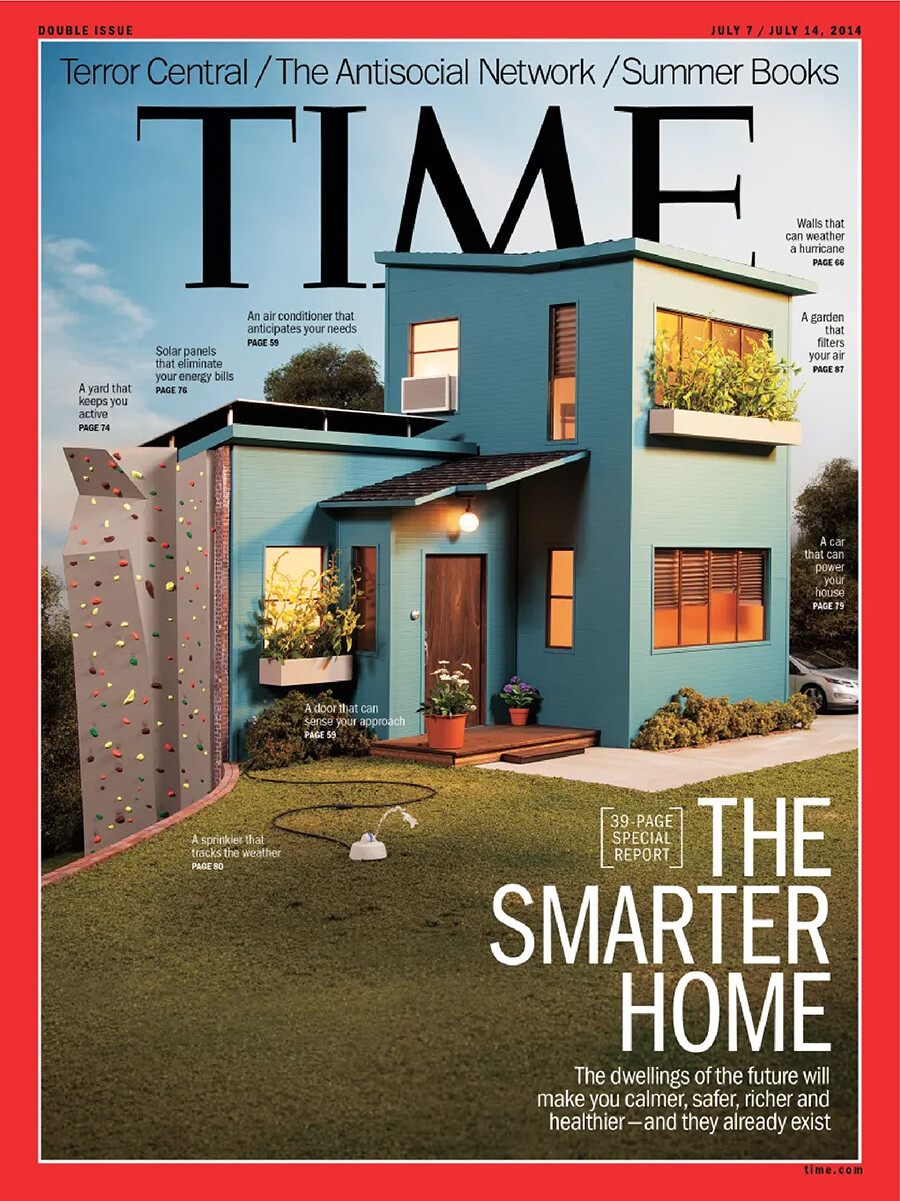

The more metaphorical network, then—the meta-network of the internet of things—is reliant on a literal network of rusty pipes and underground cables. Banham reminds us that Edison’s lightbulb would have been useless without his invention of the mains electricity delivery system, reinforcing his point that services (gadgetry and geekery) are what make modernist form possible. But even when the deployment of electrical services determines the outward form of the building (e.g., Louis Kahn’s Richards Memorial Laboratories in Philadelphia), architects go to great lengths to hide them.
We prefer our network infrastructure invisible, and consequently we elaborate nebulous metaphors such as “the cloud.” Deep down we know that the cloud is a giant server farm somewhere outside Houston, but out of sight out of mind. Timo Arnall’s film Internet Machine, shot in a data center in Spain, lingers eerily on the stacks of servers, the whirring fans, and the miles of fiber-optic cable precisely to make such metaphors tangible.
All of which goes to say that the smart home is merely the consumer entry point to a vast new economic territory of invisible infrastructure. The mundane (or even intimate) domestic data of the smart home accumulates into the “big data” of the smart city. And here there are powerful corporate forces at play—forces that our neoliberalized, austerity-riddled municipal authorities may be increasingly powerless to resist. Again the ostensible motive is efficiency: smart waste bins that know when they need to be emptied and smart traffic lights that can recalibrate themselves based on traffic flow. But these services are politicized through their transfer to the private sector.
When James Bridle quipped recently, “Beneath the paving stones, the cloud,” he was pointing to a material reality, just as Arnall was, but the political connotations of that adage are worth dwelling on.10 Who owns the cloud? Who owns the smart city? Follow the money. The real financial assets of the city will be measured less in ostentatious skyscrapers than in the invisible substrate of cables and sensors. The implications of what Keller Easterling calls “infrastructure space” for architects and architecture are not entirely clear, but what is fairly certain is that the discipline thus far lacks a truly infrastructural perspective. Data as a tool for creating parametric form has an established, if polarized, position, but a genuine network thinking has yet to infect architecture. Architecture is still focused on objects. Or, as Easterling puts it: “Architecture is making the occasional stone in the water. The world is making the water.”11
Bruce Sterling, The Epic Struggle of the Internet of Things, (Moscow: Strelka Press, 2014).
Michael E. Porter and James E. Heppelmann, “How Smart, Connected Products are Transforming Competition,” Harvard Business Review (November 2014): 65.
I quote Matt Webb, formerly of BERG, with no guarantees that he said it first.
Reyner Banham, The Architecture of the Well-Tempered Environment (Amsterdam: Elsevier, 2013), 278.
Dave Eggers, The Circle (New York: Penguin, 2013), 126.
Hannah Arendt, “The Vita Activa,” in The Portable Hannah Arendt, ed. Hannah Arendt and Peter R. Baehr (New York: Penguin, 2003), 212.
Jeffrey Myers, ed., George Orwell (New York: Routledge, 2002), 25.
Rem Koolhaas interviewed in the Guardian, March 12, 2014.
Dan Hill, “We need a Prouvé of plumbing, a Rogers of rewiring, an Utzon of U-values” dezeen, May 1, 2014.
James Bridle, “The Cloud,” Icon magazine, February 16, 2015.
Keller Easterling, The Action is the Form: Victor Hugo’s TED Talk (Moscow: Strelka Press, 2012).
